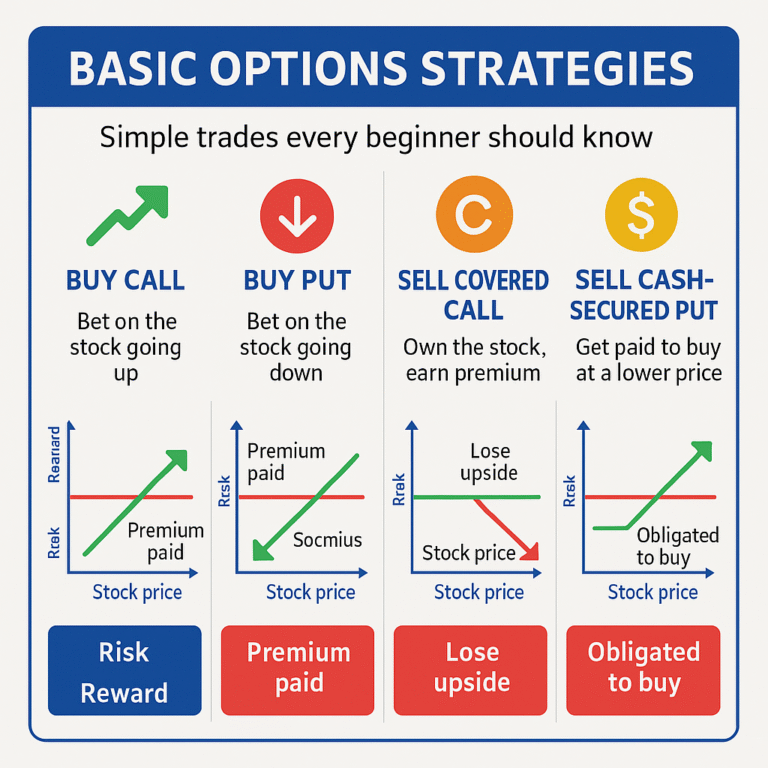Lesson 7: Basic Options Strategies — Simple Trades Every Beginner Should Know
🧠 Core Concept of Options Strategies
Now that you understand Calls and Puts, it’s time to learn how to actually use them.
This lesson covers the 4 easiest and most beginner-friendly options strategies:
- Buying Calls
- Buying Puts
- Selling Covered Calls
- Selling Cash-Secured Puts
These options strategies form the foundation for more advanced trades later.
1️⃣ Buying a Call Option
Use when you think the stock will go UP
You pay a premium for the right to buy shares at a certain price.
Example:
- AAPL is $100
- You buy a $105 Call, paying $2.00
- If AAPL rises to $115 → You make ($115 − $105 − $2) × 100 = $800
Pros:
- Low cost, high upside
- Defined risk (you only lose the premium)
Cons:
- Time decay eats value (Theta)
- Needs significant move to profit
2️⃣ Buying a Put Option
Use when you think the stock will go DOWN
You pay a premium to lock in a high selling price.
Example:
- SPY is $400
- You buy a $390 Put for $3.00
- If SPY drops to $370 → You make ($390 − $370 − $3) × 100 = $1,700
Pros:
- Profit from falling prices
- Can hedge your stock positions
Cons:
- Premium can expire worthless if no drop
- Theta decay and IV sensitivity
3️⃣ Selling a Covered Call
Use when you own shares and want to earn extra income
You sell a Call against shares you already hold.
Example:
- You own 100 shares of MSFT at $300
- You sell a $310 Call and receive $2.50 (=$250)
Outcomes:
- If MSFT stays below $310 → You keep the shares + $250
- If MSFT rises above $310 → You sell the shares at $310, still with a profit
Pros:
- Generates income passively
- Low risk if you’re holding the stock anyway
Cons:
- You cap your upside (must sell at strike if called)
- Must own 100 shares
4️⃣ Selling a Cash-Secured Put
Use when you want to buy a stock at a lower price
You sell a Put and set aside cash in case you’re assigned.
Example:
- You want to buy NVDA at $600 (current price $630)
- Sell a $600 Put, receive $7.00 (=$700)
Outcomes:
- If NVDA stays above $600 → You keep the $700
- If NVDA drops below $600 → You must buy 100 shares at $600, but your net price is $593
Pros:
- Get paid to wait for a dip
- Enter stock at a discount
Cons:
- Must be ready to buy 100 shares
- Still exposed if stock crashes hard
Go deeper into Managing Cash Secured Puts
🧮 Options Strategies Comparison Table
| Options Strategies | Market Outlook | Max Risk | Max Reward | Requires Stock? |
|---|---|---|---|---|
| Buy Call | Bullish | Premium Paid | Unlimited | ❌ |
| Buy Put | Bearish | Premium Paid | Strike − Premium | ❌ |
| Sell Covered Call | Neutral/Bullish | Losing upside | Premium + Stock Gain | ✅ |
| Sell Cash-Secured Put | Bullish/Neutral | Buy Stock at Strike | Premium Earned | 💵 (cash only) |
✅ Option Strategies Quick Quiz
- Which strategy pays you while you wait to buy stock?
- What’s the max risk when buying a call?
- What do you need to sell a covered call?
🧠 Answers
- Selling a cash-secured put
- The premium paid
- You must own 100 shares of the stock
Check out how we apply these various options strategies in our Stock Options Analysis & Trading Strategies!

